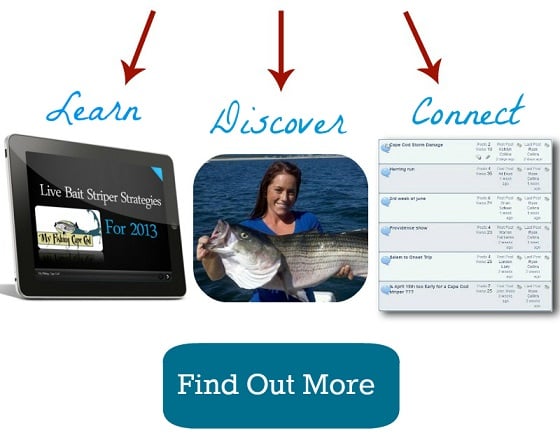Live eels work great from shore all summer long. However I believe striped bass eat eels with even more abandon during the month of October. The bass are on their way south, and they will happily slurp down an eel that happens to swim their way.
In this post I plan on divulging any little secret tip or tactic I think will help you hook up with more bass this October fishing eels from the sand. We'll even talk a little bit about areas worth tossing an eel or two during this special month.
Live Eel Gear
I have been using the Penn 440ssg for two years now with amazing results. This small and economical reel can withstand hundreds of bass up to and above the 40 pound mark. The reel is also good because small fish are fun to battle on it as well. It's a good all around choice for various situations and environments.
I pair the Penn 44ossg with a 6 foot medium action spinning rod. I like a forgiving tip with backbone to turn a good size bass. Make sure to not select a rod that is very stiff. A stiff fishing rod will exert too much pressure on the eel, resulting in the eel tearing from the hook after "not so many" casts.
I use 50 pound Power Pro braided line on the Penn 440ssg. The diameter of the line is, I believe, the same as 12 pound monofilament. This means I can pack around 150 yards of 50 pound test Power Pro onto the reel. This is plenty of line in most situations, unless you plan on fishing an area with very strong current like the Cape Cod Canal - which would require a completely different type of setup.
When fishing with eels I choose either a 5/0 or 6/0 hook or a 7/0 or 8/0 hook. I choose the size of the hook based on the size of the bass I expect to catch. If the fish are schoolies with a small keeper or two in the mix I choose a 5/ or 6/0. If the bass are big I go with the 7/0 or 8/0. Circle hooks work best in my opinion and help prevent gut hooking bass.
Of course other good things to bring along include a rag, a headlamp, 50 pound leader material and a mesh bag to transport the eels as you wade around in the water.
Technique
I prefer to use a "lob" type cast with eels as opposed to a "snap" type cast. Lobbing the eel out there will help prevent tearing the eel from the hook. A snap like cast will quickly tear the eel and send it flying off into oblivion.
Reel the eel in back towards shore at a slow pace, just enough to keep the eel from burying itself in the bottom. Sometimes it can pay to experiment with the speed of the retrieve. Bass, especially large ones, have no problem destroying an eel that is reeled in quickly along the surface. Be sure to keep your rod tip high in the sky in preparation of a bite.
When a bass hits the eel you will feel a slight to heavy "bump." As soon as you feel this bump lower your rod tip and allow the line to get tight before setting up on the fish. Try to do this without causing any unnatural tension on the line, as tension will cause the bass to immediately spit the eel in most cases.
Once the line gets taught set up on the fish. No huge hook sets are necessary if you are using a circle hook. Simply tighten up on the bass and reel him in.
Helpful Hints
1) Eel size
If there are big bass in the area and you want to target the biggest of the bunch, use the largest eel in your bucket. I've had good success using eels that were all of 2 feet and an inch around. Big stripers have no problem engulfing all but the largest of eels.
If you are not sure what size bass you will encounter, a regular medium size eel is a good bet. These casts best and are your all around best option.
If there are schoolies and small keepers around, go with a pencil size eel. The smallest eels do not cast well, however you will get more hookups using the smaller version. Small eels are much easier for these young fish to swallow, resulting in a much better hook up ratio.
2) Bass scratches on the eel
Not sure if you just felt a bite from a bass? Take a close look at the body of your eel. If you notice scratches, then you did have a bass bite the bait.
Bass will cause abrasions on the eels skin, caused by their sandpaper like teeth. This is a good way to help distinguish between a bass hit and the eel just kicking extra hard.
3) Is the eel dead?
Eels work best when they are alive. If after a while your eel appears to be lifeless, hold on just one more second before throwing him away.
Cover his eyes with your hand and if the eel is alive, he will curl his tail. As long as the eel has a curl in his tail he is good to go.
Places to Fish Live Eels from Shore
I talk a lot about inlets and estuaries on the blog and for good reason. They are awesome places to fish live eels. Estuaries are where many eels call home to begin with, so what better spot to cast one?
While most of the bass encountered in estuaries are on the small side, bass that roam open beach fronts are often much larger. I love casting eels along the beach during a flat calm, super still night. If the fish are around they will let you know by destroying any eel tossed in their direction.
Of course there are many beaches and areas on the Cape that fish better than others - especially when it comes to eels. By no means do I know of all of them, but the following locales are places where I've had success before in the past. Just click on the location name to be taken to a more in-depth article about the area.
Thanks and good luck eeling!
Ryan


